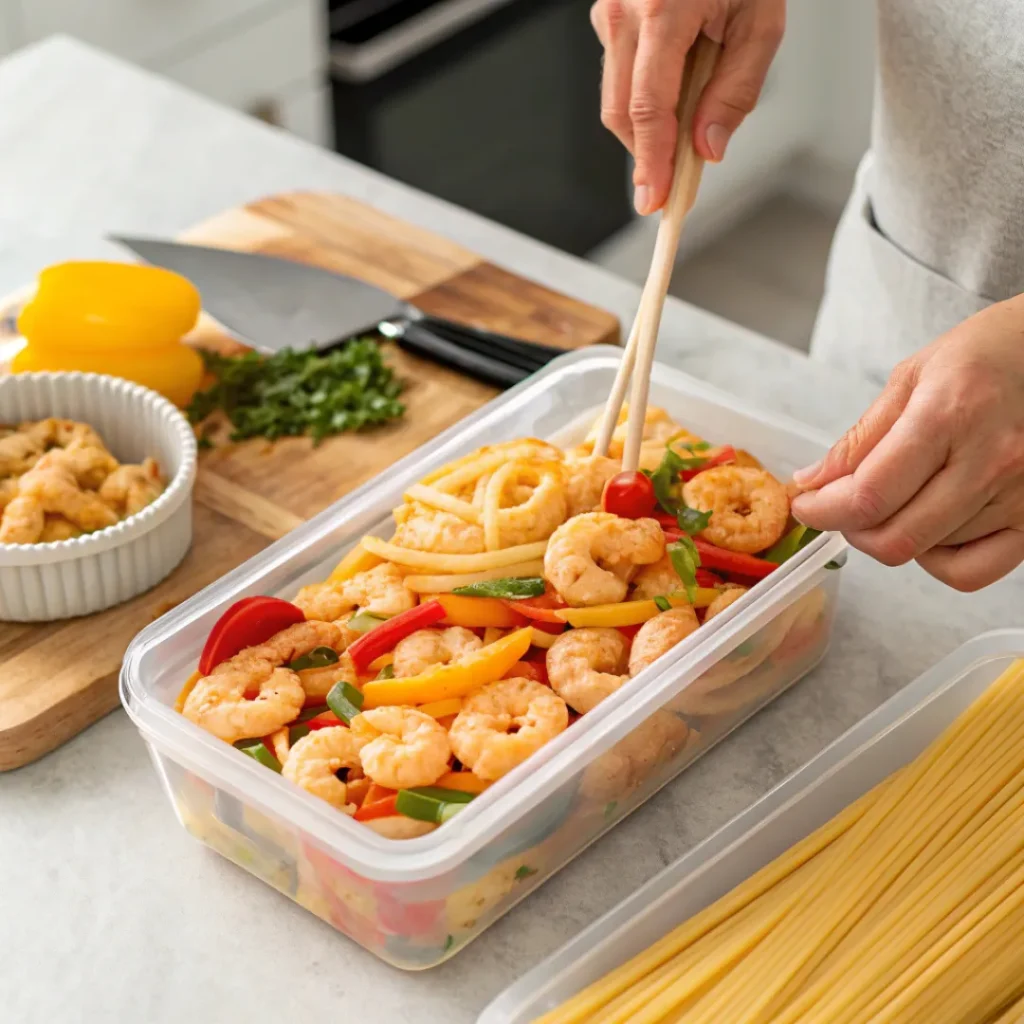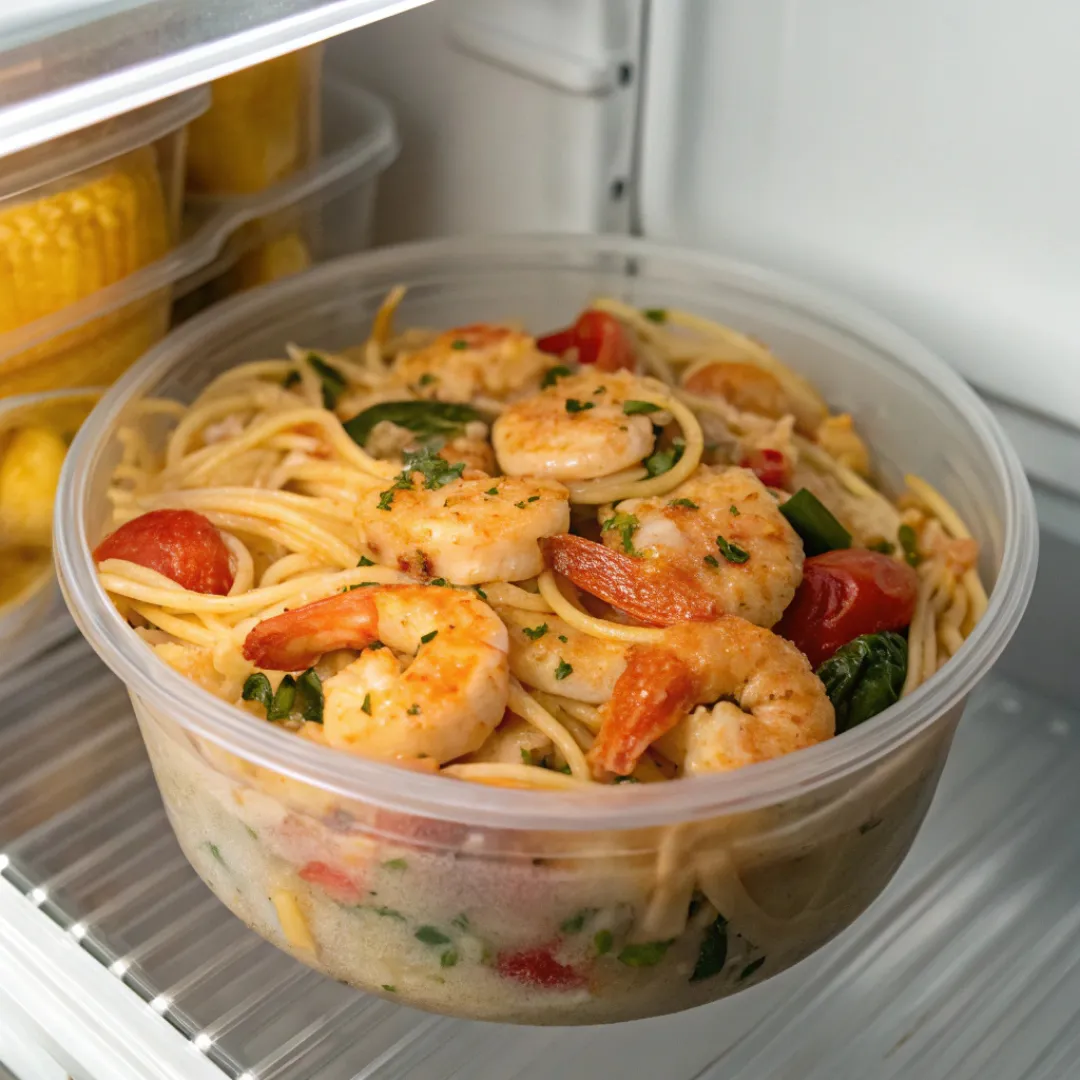Cajun shrimp pasta is a savory and creamy delight that brings together succulent shrimp, rich sauce, and a blend of Cajun spices for a burst of flavor. It’s a favorite for many households, but it’s easy to find yourself with leftovers after a meal. This leads to a common question: how long does Cajun shrimp pasta last in the fridge? Understanding the right way to store, handle, and reheat Cajun shrimp pasta is essential to preserving both its taste and safety.
This comprehensive guide will walk you through everything you need to know about keeping Cajun shrimp pasta fresh, including storage tips, best containers, proper reheating methods, and signs of spoilage.
Shelf Life of Cajun Shrimp Pasta in the Fridge
In general, seafood dishes have a shorter refrigerator life than other types of pasta due to the higher perishability of seafood. Cajun shrimp pasta typically lasts 3 to 4 days in the fridge when stored properly in an airtight container. This period allows you to enjoy the dish while it’s still fresh, flavorful, and safe to eat.
Why Only 3 to 4 Days?
- Shrimp: Shrimp and other seafood are particularly sensitive to bacterial growth, even at refrigeration temperatures.
- Dairy in the Sauce: Many Cajun shrimp pasta recipes include a cream-based sauce, which can change texture and flavor as it sits and is prone to spoilage after a few days.
- Pasta Quality: Pasta itself can start to lose its texture after a few days in the fridge, becoming mushy or overly soft.
Factors Affecting Cajun Shrimp Pasta’s Freshness
Several factors can influence how long Cajun shrimp pasta stays fresh in the fridge:
Freshness of Ingredients
The freshness of the shrimp, sauce, and other ingredients plays a major role in the pasta’s shelf life. Freshly prepared shrimp will naturally last longer than shrimp that was previously frozen.
Temperature Fluctuations
Temperature inconsistencies in your fridge can affect the storage life of your leftovers. Frequent door openings can cause fluctuations that may shorten shelf life.
Moisture and Exposure to Air
Air exposure can cause the pasta to dry out, while excess moisture can lead to bacterial growth, so storing the dish in an airtight container is crucial.
Preparing Cajun Shrimp Pasta for Storage
To ensure Cajun shrimp pasta lasts as long as possible in the fridge, it’s essential to prepare it correctly for storage. Here are steps to follow:

Cool the Pasta Quickly
Avoid leaving Cajun shrimp pasta at room temperature for more than two hours. This can expose the shrimp and sauce to bacteria that multiply rapidly at warmer temperatures.
Portion into Smaller Containers
If you have a large quantity of leftovers, dividing it into smaller portions can help it cool more quickly and store more easily.
Avoid Overcrowding the Fridge
Crowded storage areas can cause the pasta to take longer to cool, which could impact freshness.
Best Containers for Storing Cajun Shrimp Pasta
Using the right type of container is essential for maintaining freshness. Here are some container options to consider:

Glass Containers with Tight Lids
Glass containers are ideal because they don’t retain odors or stains. Look for those with an airtight seal to keep the sauce and pasta from drying out.
BPA-Free Plastic Containers
High-quality plastic containers work well for short-term storage. Choose BPA-free, airtight options to keep air and moisture out.
Freezer Bags (for Freezing)
If you plan to freeze the pasta, double-bagging in freezer bags can help protect against freezer burn. Make sure to remove as much air as possible.
Refrigeration Tips for Maximum Freshness
Once your Cajun shrimp pasta is stored in a suitable container, follow these tips to keep it as fresh as possible:
Temperature Check
Ensure your fridge is set to below 40°F (4°C). A stable, cold environment prevents bacteria from growing quickly.
Store at the Back of the Fridge
This is the coldest area of most refrigerators, which helps keep leftovers at a consistent temperature.
Avoid Opening the Fridge Too Often
Minimizing fridge openings reduces temperature fluctuations that can affect the quality of stored food.
Freezing Cajun Shrimp Pasta for Extended Storage
If you need to store Cajun shrimp pasta for more than a few days, freezing is a great option. By freezing it, you can extend its shelf life to about 1 to 2 months. This method helps preserve the flavor and texture of the pasta, making it a convenient meal for later. Just be sure to reheat thoroughly when you’re ready to enjoy it!
Freezing Tips
- Cool Completely First: Make sure the pasta is completely cool before freezing to prevent excess condensation, which can lead to freezer burn.
- Use High-Quality Freezer Containers: Airtight freezer-safe containers or heavy-duty freezer bags are best for preserving flavor and texture.
- Label and Date: Always mark the date of freezing on the container to keep track of freshness.
For more guidance on safely storing and freezing foods, visit SafeFood’s Freezing and Storage Guide. This resource provides valuable tips on maintaining food quality and safety during refrigeration and freezing.
How Freezing Affects Texture
Freezing may alter the texture slightly, especially if there is a cream sauce. Cream-based sauces can sometimes separate upon thawing, so be aware that the texture may not be exactly the same as when fresh.
Thawing Frozen Cajun Shrimp Pasta Safely
For best results, thaw frozen Cajun shrimp pasta gradually:
Refrigerator Thawing
Place the frozen container in the fridge overnight to thaw slowly. This method preserves the texture better than faster methods.
Avoid Countertop Thawing
Thawing at room temperature can lead to bacteria growth, especially in seafood-based dishes. Stick to slow, safe thawing methods.
Microwave Thawing (If Necessary)
If you’re in a hurry, you can use the defrost setting on your microwave, but be sure to stir occasionally to avoid overcooking certain areas.
Reheating Cajun Shrimp Pasta
Proper reheating is essential to preserve the creamy, rich taste of Cajun shrimp pasta. Here are the best methods:
Microwave
- Place the pasta in a microwave-safe bowl.
- Cover with a microwave-safe lid or plate to retain moisture.
- Reheat on 50% power in 1-minute intervals, stirring in between until heated evenly.
Stovetop
- Use a non-stick skillet over medium heat.
- Add a small splash of milk or broth to help revive the sauce’s creaminess.
- Stir frequently until the pasta is warmed through.
Oven
- Preheat the oven to 350°F (175°C).
- Place the pasta in an oven-safe dish and cover with foil.
- Heat for about 10-15 minutes, or until warm.
Each method has its benefits, but adding a bit of liquid, like milk or broth, helps restore the creamy texture that may have diminished during storage.
Signs of Spoilage in Cajun Shrimp Pasta
Knowing when Cajun shrimp pasta has gone bad is important for food safety. Here are signs to watch for:
Sour or Fishy Smell
A spoiled dish often has an unpleasant odor, signaling it’s no longer safe to eat.
Slimy Texture
If the shrimp feels slimy or sticky, it’s a clear sign that spoilage has started.
Separated Sauce
A separated or curdled sauce may also indicate the pasta is no longer fresh.
Visible Mold
If you see any mold, discard the entire dish, as mold spores can spread.
Trust your senses; if anything seems off, it’s safer to throw it out than risk foodborne illness.
Frequently Asked Questions
Can I eat Cajun shrimp pasta cold?
Yes, as long as it has been stored properly and is within the 3-4 day window, Cajun shrimp pasta can be eaten cold. Some people enjoy pasta cold, especially as a quick lunch option. Just make sure it was refrigerated immediately after cooking.
How can I keep the pasta from drying out when reheating?
To keep the pasta moist during reheating, add a splash of milk, cream, or broth before reheating. This can restore some of the sauce’s original creaminess, keeping the pasta from drying out.
Is it safe to freeze Cajun shrimp pasta?
Yes, freezing is a safe option for Cajun shrimp pasta. Just be mindful that cream-based sauces may alter slightly after freezing, and the pasta texture may be softer. Consume within 1 to 2 months for the best quality.
How do I know if the shrimp in my pasta has spoiled?
Spoiled shrimp usually has a strong, fishy odor and may feel slimy to the touch. If you notice either of these, it’s best to discard the dish, as seafood can harbor bacteria that cause foodborne illnesses.
Conclusion
Cajun shrimp pasta is a delicious and hearty dish, but storing leftovers safely is crucial to enjoying it at its best. Generally, Cajun shrimp pasta lasts about 3-4 days in the fridge if stored properly. Following these storage, freezing, and reheating tips will help you maintain the flavors, textures, and overall quality of your leftovers.

